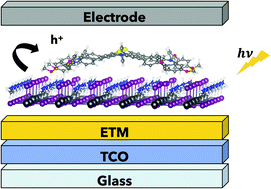Electronic structure and interfacial features of triphenylamine- and phenothiazine-based hole transport materials for methylammonium lead iodide perovskite solar cells†
Abstract
Recently, great research efforts have been devoted to perovskite solar cells (PSCs) leading to sunlight-to-power conversion efficiencies above 25%. However, several barriers still hinder the full deployment of these devices. Critical issues are related to PCE stability and device lifetimes, which could be improved by targeted engineering of the hole transport material (HTM). Indeed, the HTM is not only responsible for transporting holes and preventing direct contact between the photo-active perovskite and the charge collector layer, but it plays important structural and protective roles too. As alternatives to the widely used yet expensive and unstable Spiro-OMeTAD, organic HTMs based on triphenylamine (TPA) and phenothiazine (PTZ) moieties have been proposed. However, their performances in PSC devices, and in particular their interfacial properties with the most popular methylammonium lead iodide perovskite (MAPI) still need investigations to be fully determined. In this framework, here we report a first-principles study on the structural and the electronic properties of a recently designed TPA and PTZ-based HTM (HTM1) and its interface with the MAPI (001) surface, considering both the PbI2- and the MAI-terminations. We also addressed already known HTM molecular systems to allow for a direct comparison with the recently proposed HTM1: we characterized the molecular parameters and the MAPI/HTM interfacial properties for Spiro-OMeTAD, PTZ1, and PTZ2. Our results suggest that good adhesion properties do not ensure effective and efficient MAPI-HTM hole injection. Despite the theoretical good alignment between HTM1 HOMO and MAPI valence band edge, our results for the mutually polarized interface point out the lack of a sufficient driving force for hole transport. While the hole mobility of HTM1 outperforms those of the other HTM molecules, for this HTM molecule, our findings suggest the application of lead halide perovskite compositions other than MAPI, with substituents that lower its valence band maximum potential value.



 Please wait while we load your content...
Please wait while we load your content...